"One of the greatest challenges of modern astrophysics is understanding how various structures, such as galaxies and galaxy clusters, form within the framework of the Big Bang cosmology.
The current theory of structure formation, the extension of the Big Bang model called the Cold Dark Matter (CDM) scenario, predicts that massive galaxies and galaxy clusters were built from smaller galaxies that collided and merged, inducing bursts of star formation and resulting in the different types of structures observed today.
The sequence of events is thought to be seeded by quantum fluctuations in the very early Universe. These tiniest fluctuations were stretched by many orders of magnitude during a brief period of extremely rapid exponential expansion of the Universe called inflation. The growth of structures is thought to be governed by mysterious "dark matter" which constitutes about 85% of all matter in the Universe. The entire history of the cosmos in all its complexity is governed by a handful of cosmological parameters, such as the density of ordinary matter (baryons), the density of ``dark matter'', thought to consist of weakly interactive particles, and ``dark energy''.
The theory is both elegant and simple as it connects the processes operating on the smallest imaginable scales during the first 10-33 seconds in the evolution of the Universe to the formation of the largest structures observed today."
Formation of the large-scale structure in the Universe: filaments
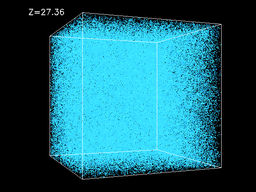
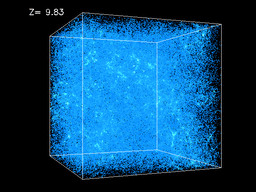
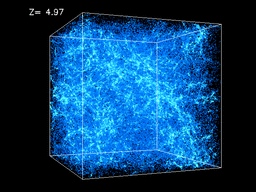

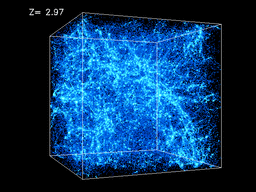
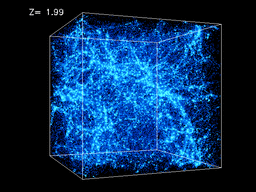
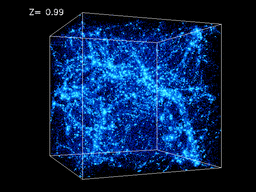
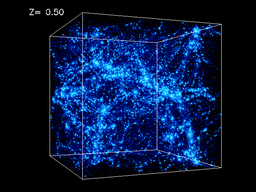

"The movie stills pictured above illustrate the formation formation of clusters and large-scale filaments in the Cold Dark Matter model with dark energy. The frames show the evolution of structures in a 43 million parsecs (or 140 million light years) box from redshift of 30 to the present epoch (upper left z=30 to lower right z=0). Click to see the full-resolution version of each panel. At the initial epoch (z=30), when the age of the Universe was less than 1% of its current age, distribution of matter appears to be uniform. This is because the seed fluctuations are still fairly small. As time goes on, the fluctuations grow resulting in a wealth of structures from the smallest bright clumps which have sizes and masses similar to those of galaxies to the large filaments. Notice the filament spanning the entire box from left to right and how it becomes more and more pronounced with time. Also, note that it does not change much between z=0.5 and z=0 (i.e., the last two panels). This is because the expansion of the universe is in the stage of acceleration as the "dark energy" becomes dominant at z<1. On large scales seen here, gravity cannot compete with the dark energy-driven acceleration and the growth of structures ceases. As the contraction of large-scale structures is halted they expand with the universe and appear "frozen" in our co-moving system of coordinates."
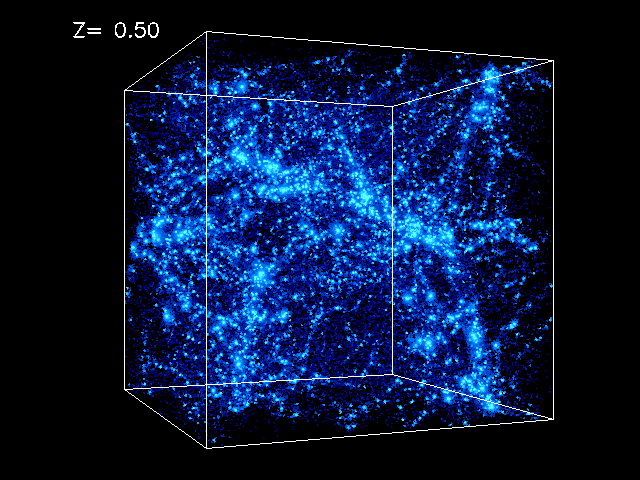

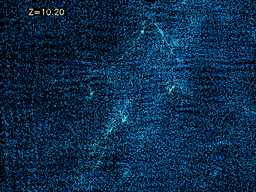

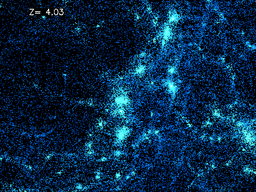
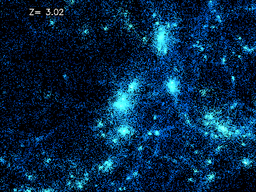
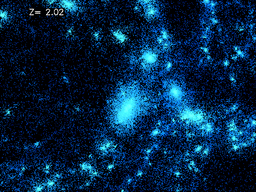


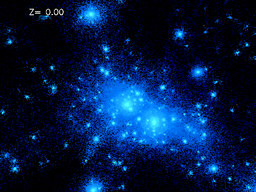
"Formation of a group of galaxies quite similar to our Local Group in which our galaxy, the Milky Way, is approaching our biggest neighbour the Andromeda Galaxy. The region shown here is 1/10 of the box shown in the filament formation page and is equal to 4.3 megaparsec or 14 million light years. Our "camera" is tracking the progenitor of the group so that it is always new the center of the field of view. The formation of an object such as our Local Group proceeds hierarchically in the Cold Dark Matter models. Small-mass objects form first at z>5, they quickly grow in size and violently merge with each other, creating increasingly larger and larger system. This galactic "cannibalism" persists even to the present day epoch (z=0). Indeed, the two main objects that you can see approaching at z~0, will also merge in about one billion years into the future. Note that many of the "cannibalized" systems do not loose their identity and become satellites orbiting in the gravitational pull of larger systems. The groups like the one modeled in these simulations are very common in the Universe. In fact, up to half of all galaxies are thought to be part of groups of different sizes."
To me these stills all look like my LED installation but on a more complicated level.
I have said before that I am intrigued by the possibility of making something which references space not only visually but in terms of representing real data, and this is a perfect opportunity.
My ideas so far are as follows,
My ideas so far are as follows,
I could make a suspended box filled with a network of LEDs that represent one of these stills, carefully copied from the images
I could find the data used to make these simulations and run it through one of the programs I have been investigating to make a screenbased reproduction of the same simulation
Or I could make a suspended box of LEDs which *run from the simulation data*...
If anyone has the slightest clue how to do this that would be really useful!
simulations were performed at the National Center for Supercomputer Applications
by Andrey Kravtsov (The University of Chicago) and Anatoly Klypin (New Mexico State University).
Visualizations by Andrey Kravtsov.
by Andrey Kravtsov (The University of Chicago) and Anatoly Klypin (New Mexico State University).
Visualizations by Andrey Kravtsov.
This is right up my strasse. The conundrum is how do you represent something in an artwork that is already amazing visually? It makes me think of boxes of 'space' that could be enormous installation pieces that the viewer becomes part of. Planetariums are a good place to start!
ReplyDelete